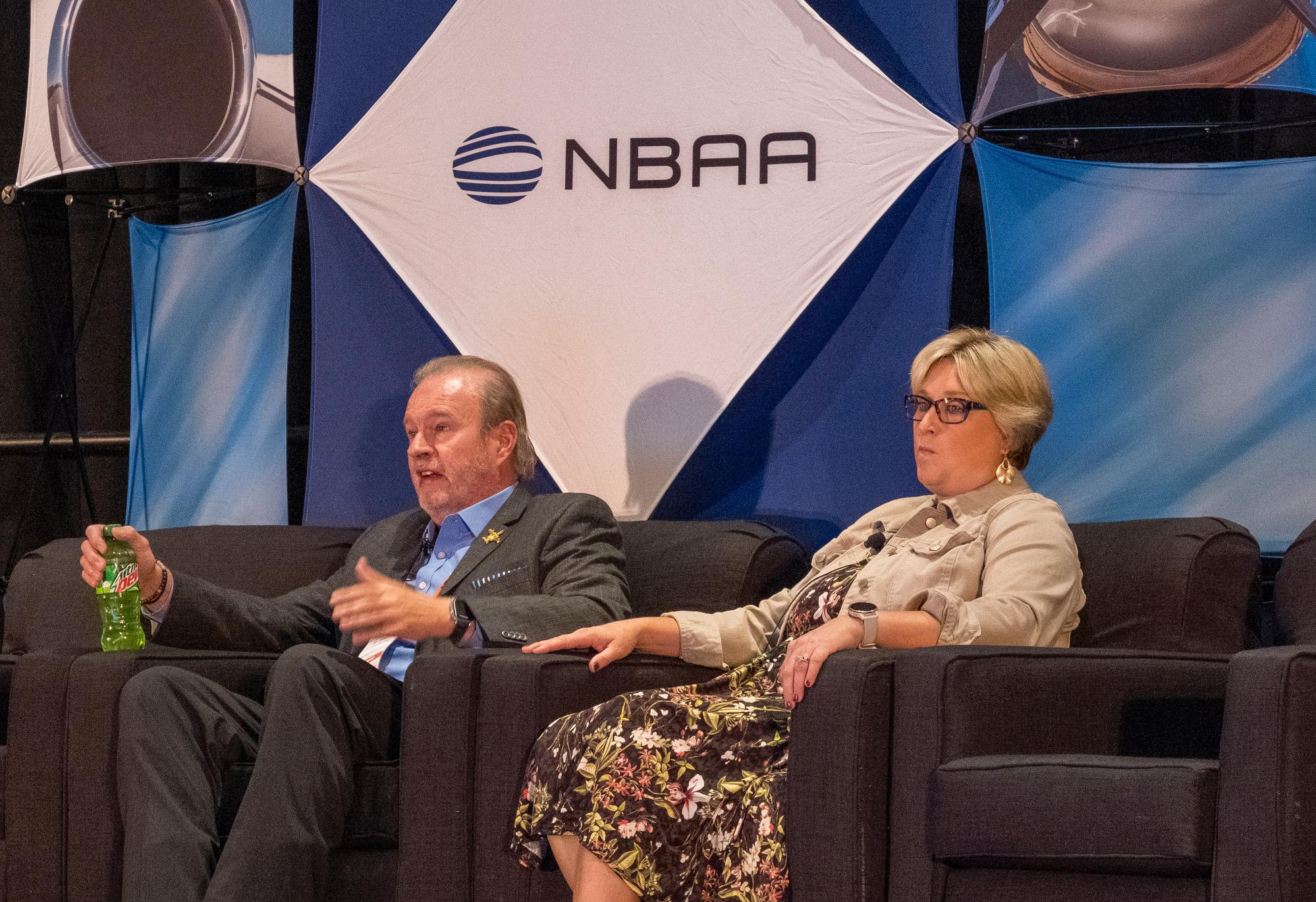
AirComp Calculator CEO Christopher Broyhill (left) and Jenny Showalter, Chief Motivational Officer at Showalter Business Aviation Career Coaching, speak at the NBAA Small Operator’s Symposium.
The Oct. 19 session of the NBAA Business Aviation Convention & Exhibition (NBAA-BACE) Small Operator’s Symposium started with a conversation that is foremost on the minds of many flight department managers, no matter how large or small: How to set the right salary and benefit levels.
Do not let the symposium’s title deter you. Most business aviation flight departments fall in the “small operator” category, with just one or two aircraft and a handful of people. The payroll challenges, however, face all of us in business aviation, no matter the size of the flight department.
First, a caveat. I have been running small flight departments for quite a while and the compensation issue has vexed me in all its forms. I have had trouble hiring good people as well as retaining those people. Looking into my crystal ball, I think things are only going to get worse. You may have read the current Boeing study, “Pilot and Technician Outlook: 2021-41,” which tells us that the global commercial fleet will need 602,000 new pilots and 610,000 new maintenance technicians over the next 20 years. I do not foresee anywhere near those numbers coming out of our aviation schools.
The symposium’s speakers have “boots on the ground” expertise on this subject. AirComp Calculator CEO Christopher Broyhill has published two books on the subject and has performed retention/compensation analyses for over 100 flight departments. Jenny Showalter, Chief Motivational Officer at Showalter Business Aviation Career Coaching, has specialized in one-on-one coaching and business aviation recruiting. Both offered invaluable ideas about what is facing us as an industry and how we can begin to address the challenges.
Broyhill began by pointing out that compensation is only a third of the problem, which he likened to a three-legged stool that requires all three legs to stand. The issues include salary, quality of life, and culture.
We all focus on compensation, perhaps, because it is the only leg of the stool that can be easily quantified. While pay and benefits have always been an issue for all branches of aviation, it has become more acute lately because of the increasing demand of the airlines and the decreasing supply of pilots. Broyhill noted that some companies recoil that the “guys up front may be making more than the guys in back,” but that we need to educate Human Resources departments that they cannot compare flight department personnel to other parts of their companies.
“You need to compare pilot compensation in your company to the rest of the industry, not the rest of the company,” he said. Another key takeaway for managers is this: “You may not think you have an airline problem but you do. You could lose people to the flight department next door because they lost people to the airlines.”
Broyhill and Showalter polled the audience on a variety of topics and one of the surprising results was when they asked for a ranking of reasons people leave business aviation. Salary compensation came in second. The top reason given was quality of life.
Broyhill related a story of a pilot who worked for the same flight department for more than 10 years who asked for an unscheduled week off so he could take care of his young kids while his wife had to be away to take a care of her father, who had sudden health problems. His request for time off was denied and he quit that day. We in business aviation are used to being on call almost perpetually and losing scheduled vacations. We tend to look at airline schedules with sacrosanct time off as the grass that is greener.
The final leg of the stool is flight department culture, which is often better in business aviation, but can also be much worse. If the flight department preaches and practices safety first, and backs that up with excellent equipment and training, pilots and mechanics may be willing to overlook other detractors. But a flight department with toxic elements can chase out people no matter how high their compensation or quality of life may be.
The annual NBAA Compensation Survey is obviously a great place to start when exploring ways to improve personnel retention. But as today’s session proved, there are other factors to consider. The discussion will continue with a Wednesday session titled “Current Compensation Configurations.” If you have an interest in compensation trends at present and in the future, the session is a must-attend event.
